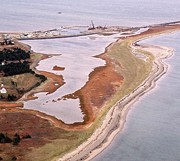
Flooding can also occur in coastal areas of New Brunswick. Floods can be caused by unusually high tides, or storm surges. Land in estuarine areas can be at particular risk of flooding as high river flows, marine tides and storm surge effects can act either alone or in combination to produce high water levels. Storm surges are episodes of high sea level caused by strong winds, often increased further by unusually low air pressure. Storm surges usually affect New Brunswick in the fall and winter seasons, when strong low pressure systems pass by offshore.
During a storm surge, periods of strong winds drive water towards the shoreline, significantly increasing the sea level. If the wind is blowing towards an estuary, the surge effect can be boosted even more, as the water is funnelled into the estuary area. The longer strong onshore winds persist, the greater the surge effect. Low air pressure literally sucks the sea surface upward, and this effect can be significant with intense low pressure systems. The worst surge impacts are caused when a surge due to wind and low pressure coincides with an unusually high tide. Sea levels can be raised over a metre above normal tide predictions. The impact of a storm surge may be offset if there is coastal sea ice present, although if the ice breaks up, it can add to the damaging effect of flooding and wave action. Storm surges can also be caused by tropical storms systems (hurricanes). The combination of high winds, heavy wave action and flooding during a storm surge can cause extensive damage to affected areas.
Current and future coastal flooding estimates for various parts of the New Brunswick coast.
